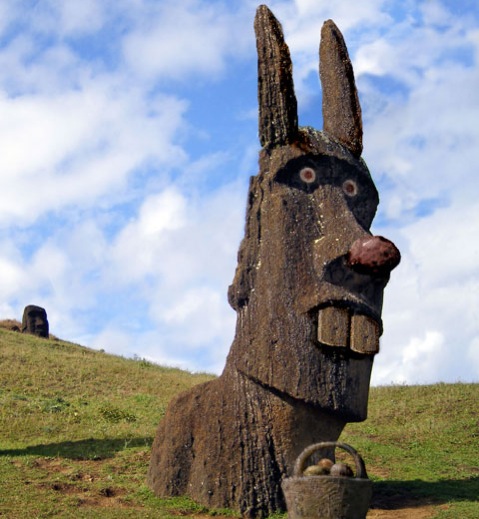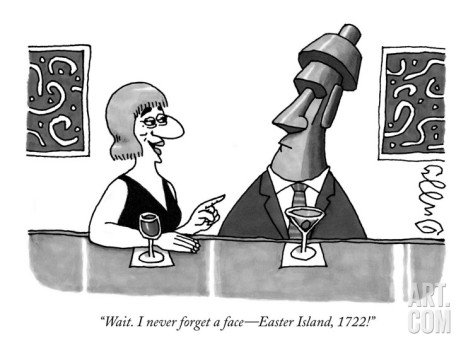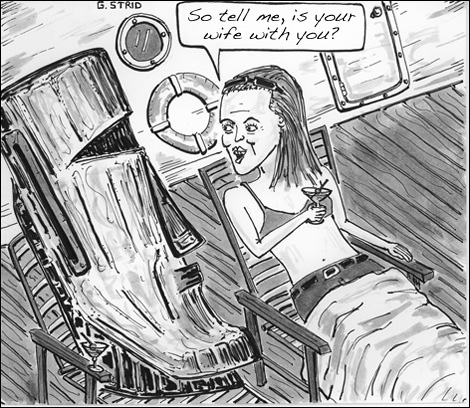
A Moai’s Easter Sunday surprise (Photo: jantoo.com)
For the French, a large chocolate bell flies in from Rome with gifts and promises of redemption. For Americans, a large rabbit showers old and young alike with multicolored eggs and chocolates unrelated to moving a stone from in front of a tomb.
And the current 6,000 inhabitants of the South Pacific’s Easter Island? Well, many of them would rather forget the whole thing.
Dutch Explorer Jacob Roggeveen at first thought he’d stumbled on the legendary continent of Terra Australis when he sighted the isolated island on Easter Sunday, 1722. With with no picture postcards back then, we’ll never know what he actually saw; but apparently it wasn’t natives tossing shrimp on their barbies. He decided to sail on after christening the subterranean-volcano-formed land mass Paaschen Eyland.
In 1774, Captain Cook got a tummy ache (stale Easter eggs may have been the only food he could find on the desolate island), the weather was terrible and the crew was laconic, so he left after only three days. Millie and I have had similar experiences on cruises in the Bahamas.
Cook, who no doubt would have written a scathing review of the place on Trip Advisor, nevertheless gets credit for the discovery, even though (to the dismay of Kon-Tiki author Thor Heyerdahl) Polynesians (not South Americans) had beaten him there by as much as a thousand years.
Oral tradition holds that the original settlers first may have called their new home Te Pito O Te Henua — The Navel of the World, perhaps because there was little else to do on the isolated island but stare at one’s navel.
Commemorating this hypothesis is a large round stone, said to have been brought from Polynesia by the first king, Hotu Matu’a, encircled by a stone wall. Four smaller stones, recently placed in a circle around the Big Kahuna, allow visitors to sit and, yes, contemplate it.

A barfly rediscovers Easter Island. (Cartoon: TheNew Yorker)
The unimaginative truth is that the residents’ preferred name for their home dates only from 1863, when officials noted that the triangular shape of the land mass resembles that of the French Polynesian island, Rapa, only larger. Thus it became Rapa Nui (Big Rapa). Sorry.
The island itself is much larger, and more various, than I’d anticipated; and from the first moai to the the last site visited — the small quarry from which the softer, red stone was mined to create the distinctive rust-colored topknots that crown the stark, umber moai, it was impossible not to sense the living force, or mana that seems to radiate from the scores of “Living Faces” that inhabit this Pacific paradise.
Think about your stern-faced dorm counselor in college and multiply that by 400 or so.
Everyone from Thor Heyerdahl, whom our naive guide constantly referred to as “Señor Kon-Tiki,” to Japanese, American and Rapanui archeologists, seems to have had a hand in unearthing, restoring or re-erecting fallen moai on expansive ahu — stone platforms, where the figures, facing inward across the island, once again remind the native population of its Polynesian heritage.
At the largest quarry, Rano Raraku, where the tallest (12 meters) moai still lies attached to the volcanic stone, unfinished statues lie side-by-side, Siamese-twin-like, under-and-above, to make the best use of the volcanic rock. IKEA could take a lesson from these in-production moai, perhaps the world’s first punch-out, some-assembly-required specialty items.
Populating the surrounding slopes, like a giant outdoor Reject China Shop, are scores of upright, tilted or lounging moai that didn’t make the cut, fell over and cracked, or just decided they liked the view.
At some point, the natives simply lay down their tools and stopped carving.
Then the Moai were toppled around the island, to the point that only one was left standing in 1840.
Could there have been a little-known War of the Moai Hairdressers, infighting among members of the twelve tribes who carved the stylish red topknots? Anyone who remembers New Orleans hair salons and Pontchartrain Beach beauty competitions in the 1950s will know the fury of a hairdresser bested.
In the 1500s, the annual Birdman competition began, with members of the twelve tribes swimming to a small, rocky outpost where terns would nest each spring. The leader of the tribe whose champion returned with the first egg was declared king of the island for the next year, diminishing the importance of the moai, establishing a primitive form of democracy on the island and anticipating the rolling of Easter eggs on country-club lawns by centuries.

Unforgettable, that’s what you are . . . . (Cartoon: splendidmarbles.com)
By the end of the second day of our visit, Millie had gotten Easter Island, as we say, “out of her system.” We’d talked about it, schemed how we’d get there, and taken the plunge. Then it was time to relax in a deck chair, reminisce and plan how to celebrate Easter at Madewood this year.
 NOLAbeings Multimedia artist Claire Bangser created NOLAbeings as a portrait-based story project that marries...
NOLAbeings Multimedia artist Claire Bangser created NOLAbeings as a portrait-based story project that marries...  Voodoo in New Orleans: Reviving history: New Orleans fortune telling This article takes a deep dive into the history of Voodoo in New Orleans, its hybridization with Catholicism, and its present-day place in the city's culture. The author visits fortune-tellers in the French Quarter, using their guidance as a tool for introspection rather than a deterministic predictor of the future. Through her experiences in New Orleans, the author feels a mystical connection to both the past and the future.
Voodoo in New Orleans: Reviving history: New Orleans fortune telling This article takes a deep dive into the history of Voodoo in New Orleans, its hybridization with Catholicism, and its present-day place in the city's culture. The author visits fortune-tellers in the French Quarter, using their guidance as a tool for introspection rather than a deterministic predictor of the future. Through her experiences in New Orleans, the author feels a mystical connection to both the past and the future. 